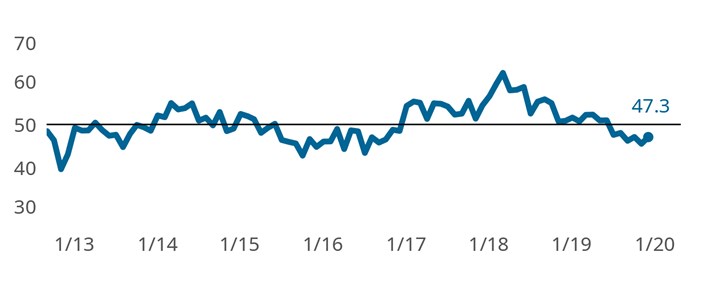Index Ends Year with Expanding Supplier Deliveries
December Finishing Index: 47.3
The Finishing Index ended the year at 47.3, representing a mild contraction in overall business activity compared to the prior month. Index readings above 50 indicate expanding activity, while values below 50 indicate contracting activity. The further away a reading is from 50 the greater the magnitude of change. Gardner Intelligence’s review of the latest data found that the Index was supported by expanding supplier deliveries, no change in employment activity and only mild contraction in exports and new orders. The Index — calculated as an average of its components — was pulled lower by a quickening contraction in production and a prolonged contraction in backlog activity.
The end of 2019 marked 14 consecutive months of contracting backlog activity. The trend in backlogs during this time has been one of accelerating contraction which registered a fresh low multiyear low as recently as November. The reduction in backlog activity is in part explained by the fact that production readings have exceeded those of new orders approximately 75% of the time since early 2018. Only in recent months has this relationship been reversed. This transposition may potentially signal the start of a rebalance between production and order demand.
Finishing Business Index

The Finishing Index closed the year at 47.3. Expanding supplier deliveries was offset by contracting production and backlog activity.
Backlogs Reported an Accelerating Contraction in 2019
The contraction in backlog activity accelerated throughout 2019. Monthly production readings in the last two years frequently exceeded those of new orders, this in part is assumed to have influenced backlog levels.
RELATED CONTENT
-
Painting Over Powder Coating
How safely can they apply their wet paint over our powder coated parts?
-
Coating Thickness Measurement: The Fundamentals
A review of available test methods, common applications and innovative instrumentation...
-
Improving Transfer Efficiencies in Coating Operations
There are many methods for addressing electrostatic grounding in metal painting processes, and Tim Ulshafer from Mueller Electric says the best method for your process is a simple and worthwhile exercise.


.jpg;width=70;height=70;mode=crop)














